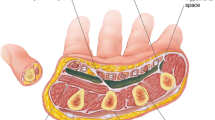Abstract
The aim of the study was to assess acute-phase multidetector CT (MDCT) findings in wrist injuries. We retrieved all emergency room MDCT requests processed in the period from August 2000 to May 2003. All patients with a wrist injury who underwent MDCT initially were included. Imaging studies were evaluated in relation to injury mechanism, fracture location, and fracture type. A total of 6422 MDCT examinations were performed during this 34-month period, and 38 patients (24 male, 14 female, age range 21–73 years, mean age 40 years) met the inclusion criteria. MDCT revealed 56 fractures and 7 dislocations in 29 patients. In 9 patients (24%) MDCT findings were normal. Eleven patients (29%) underwent surgical procedures. The main injury mechanism was a fall (58%). In 33 cases the primary radiograph was available. Compared to primary radiographs, MDCT revealed 9 occult fractures, mainly in small carpal bones. In 14 cases a suspected fracture (of the scaphoid in 7 cases) was ruled out by MDCT. Due to high-quality two-dimensional reformatting, MDCT examinations were not dependent on the wrist’s position in the CT gantry. In the comparison with radiography, MDCT detected occult fractures and ruled out suspected fractures, both mainly in the small carpal bones. High-quality two-dimensional reformats gave significant information about the fracture anatomy. MDCT provides fast and valuable information in assessing complex wrist fractures or when the primary radiograph is equivocal.




Similar content being viewed by others
References
Rydberg J, Buckwalter KA, Caldemeyer KS, et al (2000) Multisection CT: scanning techniques and clinical applications. Radiographics 20:1787–1806
Novelline RA, Rhea JT, Rao PM, Stuk JL (1999) Helical CT in emergency radiology. Radiology 213:321–339
Greenspan A (2000) Orthopedic radiology: a practical approach, 3rd edn. Lippincott Williams & Wilkins, Philadelphia
Langhoff O, Andersen JL (1988) Consequences of late immobilisation of scaphoid fractures. J Hand Surg Br 13:77–79
Gaebler C, Kukla C, Breitenseher M, Trattnig S, Mittlboeck M, Vecsei V (1996) Magnetic resonance imaging of occult scaphoid fractures. J Trauma 41:73–76
Filan SL, Herbert TJ (1995) Avascular necrosis of the proximal scaphoid after fracture union. J Hand Surg Br 20:551–556
Perron AD, Brady WJ, Sing RF (2001) Orthopedic pitfalls in the ED: vascular injury associated with knee dislocation. Am J Emerg Med 19:583–588
Brondum V, Larsen CF, Skov O (1992) Fracture of the carpal scaphoid: frequency and distribution in a well-defined population. Eur J Radiol 15:118–122
Steinbach LS, Smith DK (2000) MRI of the wrist. Clin Imag 24:298–322
Breitenseher MJ, Gaebler C (1997) Trauma of the wrist. Eur J Radiol 25:129–139
Dorsay TA, Major NM, Helms CA (2001) Cost-effectiveness of immediate MR imaging versus traditional follow-up for revealing radiographically occult scaphoid fractures. AJR Am J Roentgenol 177:1257–1263
Lohman M, Kivisaari A, Vehmas T, et al (1999) MR imaging in suspected acute trauma of wrist bones. Acta Radiol 40:615–618
Brydie A, Raby N (2003) Early MRI in the management of clinical scaphoid fracture. Br J Radiol 76:296–300
Breitenseher MJ, Metz VM, Gilula LA, et al (1997) Radiographically occult scaphoid fractures: value of MR imaging in detection. Radiology 203:245–250
Raby N (2001) Magnetic resonance imaging of suspected scaphoid fractures using a low field dedicated extremity MR system. Clin Radiol 56:316–320
European Commission (2001) In: Radiation protection 118 referral guidelines for imaging. Office for Official Publications of the European Communities, Luxembourg, p. 19–22
Author information
Authors and Affiliations
Corresponding author
Rights and permissions
About this article
Cite this article
Kiuru, M.J., Haapamaki, V.V., Koivikko, M.P. et al. Wrist injuries; diagnosis with multidetector CT. Emergency Radiology 10, 182–185 (2004). https://doi.org/10.1007/s10140-003-0321-4
Received:
Accepted:
Published:
Issue Date:
DOI: https://doi.org/10.1007/s10140-003-0321-4




